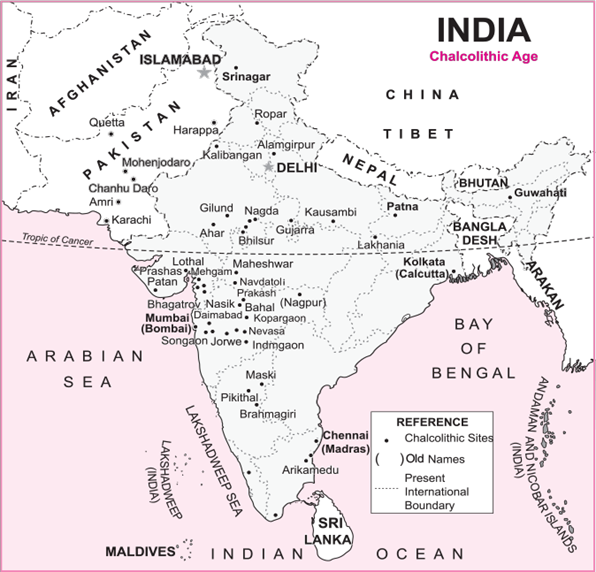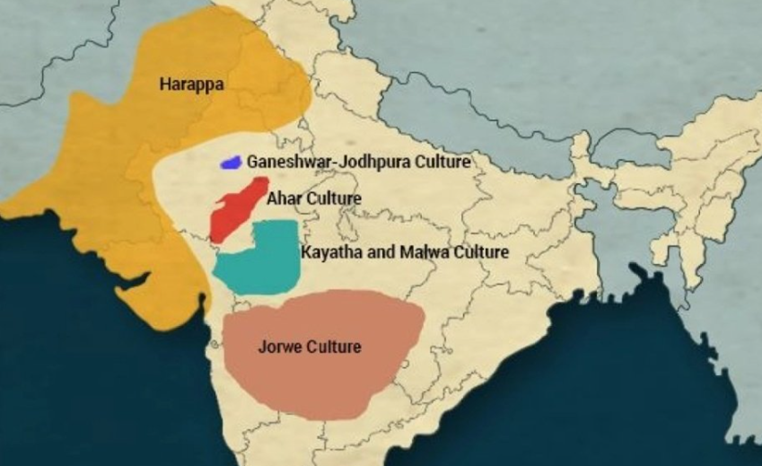Prehistoric-period / Prehistoric period / Chalcolithic Period
Introduction
- Several cultures started using metal, mostly copper and low-grade bronze with the end of the Neolithic Age.
- The culture based on the use of copper and stone was termed as Chalcolithic, meaning stone-copper Phase.
- The term Chalcolithic means “copper” and “stone” or Copper Age; it is also known as the Eneolithic or Aeneolithic.
Chalcolithic Culture in India
- In India, the Chalcolithic period spanned around 2000 BC to 700 BC.
- The culture was mainly seen in the Pre-Harappan phase but extended to the Post-Harappan phase in many places.
- The people were mostly rural and lived near hills and rivers.
Characteristics of this Culture include:
Pottery
- Polychrome painted pottery was a main identifying characteristic of the Chalcolithic period.
- Ceramic forms found on Chalcolithic sites include “fenestrated pottery,” pots with openings cut into the walls.
Domestication of Animals
- Farmers raised domestic animals such as sheep-goats, cattle, and pigs, supplemented by hunting and fishing.
- Milk and milk by-products were important, as were fruit trees such as fig and olive.
Agriculture
- The major crops cultivated were barley, wheat, lentil, bajra, jowar, ragi millets, green pea, green and black gram.
- Traces of rice cultivation are also found, showing that their food included fish and rice.
- Eastern India produced rice and Western India produced barley.
Houses and Burial Styles
- Houses built by Chalcolithic farmers were constructed of stone or mudbrick.
- One characteristic pattern is a chain building, a row of rectangular houses connected to one another by shared party walls on the short ends.
- Burials varied widely from group to group, from single interments to jar burials to small box-shaped above-ground ossuary and even rock-cut tombs.
Tools and Weapons
- Metals such as copper and its alloys were used to make knives, axes, fishing hooks, chisels, pins, and rods.
Art and Craft
- The people of Chalcolithic Age were expert coppersmiths, ivory carvers, lime makers, and terracotta artisans.
- Ornaments were made from semiprecious stones and beads such as agate, jasper, chalcedony, and carnelian.
- People had knowledge of spinning and weaving, and flax, cotton, and silk thread were found at sites in Maharashtra.

Chalcolithic Cultures Identified on Basis of Their Geographical Location
i. Ahar Culture
- The Ahar culture, also known as the Banas culture, is among the earliest Chalcolithic cultures of India.
- Major excavated sites are Ahar and Balathal in Udaipur district, Gilund in Rajsamanad district, Ojiyana in Bhilwara district Rajasthan.
- Ahar culture had a rich ceramic tradition consisting of Tan ware, thin Red ware, Black and Red ware, and Grey ware.
- Shapes include dishes, dish on stands, and globular.
- Available radio-carbon dates (calibrated) suggest a time bracket of 2025 BC— 1270 BC for the Chalcolithic Phase.

ii. Kayatha Culture
- Named after type site Kayatha, in Ujjain district, Madhya Pradesh
- Radiocarbon dates suggest a period of 2000 to 1800 BC
- Ceramics include chocolate slipped ware (Kayatha ware), bowls, storage jars, and basins
- Similarities with pre-Harappan sites
- People lived in small huts with well-rammed floors and wattle and daub walls
- Mixed economy: subsistence farming, stock raising, and hunting-fishing
- Grew barley and wheat, domesticated animals included cattle and sheep/goat
- Horse remains found in Chalcolithic level at Kayatha
- End of culture ascribed to an earthquake

iii. Malwa Culture
- Predominant chalcolithic culture of central India, with a wide distribution of sites in Malwa region
- First identified in excavations at Maheshwar, on river Narmada
- Radiocarbon dates place culture in 1900-1400 BC
- Sites mostly found on the banks of the tributaries
- Subsistence based on farming of wheat, barley, jawar, rice, legumes, oilseeds, and fruits
- Material culture includes Malwa ware, buff or cream slipped with painted patterns in dark brown, as well as other ceramic types
- Religious beliefs reconstructed from fragmentary evidence such as terracotta female and bull figurines
- Decline of the Malwa culture placed around 1400 BC, coinciding with that of Ahar culture
iv. Jorwe Culture
- Most important and characteristic chalcolithic culture of Maharashtra, extending almost all over the present state except the coastal strip on the west and Vidarbha in the northeast
- Named after type site of Jorwe in Ahmadnagar district, Gujarat
- Discovered in 1950
- Large centers found in Prakash in the Tapi valley, Daimabad in the Pravara-Godavari valley, and Inamgaon in the Bhima valley
- Early Jorwe houses rectangular, while late Jorwe ones circular
- Many Jorwe sites classified as villages, most about 2 ha in extent
- Subsistence based on dry-farming with stock-raising and hunting-fishing as ancillary activities
- Crops grown include barley, wheat, jowar, rice, ragi, green pea, grass pea, lentil, and green and black gram
- Mode of disposal of the dead involved child burials in urns laid in pits and chopping off portion below ankles in adult burials
- Many settlements deserted at end of second millennium BC for climatic deterioration

v. Ochre Coloured Pottery Culture
- Named after a ceramic type which is extremely rolled and fragile with a wash of red ochre which is easily washed off
- Led a sedentary existence, similar to many early farming communities of this period
- Domesticated animals like cattle and evidence of cultivated crops like rice and barley provide information on their subsistence practices
- Found in Rajasthan, Punjab, Haryana, and western Uttar Pradesh
- Chronological span ranges from 2600 to 900 BC
- Assigned to pre-Harappans, Harappans, or Late Harappans, Aryans, or tribal association
vi. Painted Grey Ware (PGW):
- PGW is a fine, smooth, even-colored grey pottery with a thin fabric.
- It was made out of well-worked, high-quality clay, and was a deluxe ware, forming a small percentage of the total pottery assemblage.
- PGW culture dates from 1100-500/400 BCE, with a wide geographical distribution.
- Apart from the plains, it has been found in hilly regions such as Kumaon and Garhwal.
- Structural remains at PGW levels consist mainly of wattle-and-daub and mud huts.
- Unbaked and baked bricks were found at Hastinapura, while Jakhera represents a fairly-evolved proto-urban stage of this culture.
- The PGW sites indicate a subsistence base that included cultivation of rice, wheat, and barley, with animal husbandry also practiced.
Thus, in the Chalcolithic period, copper predominated in metalworking technology.
Hence it was the period before it was discovered that by adding tin to copper one could create bronze, a metal alloy harder and stronger than either component.
In relevance to India, to sum up, the scenario in north, west and central India in the period spanning from beginning of the 3rd millennium – 800 BCE speaks of a great deal of diversity.
Overall, the survey of Chalcolithic sites in India, also highlights the regional diversity

